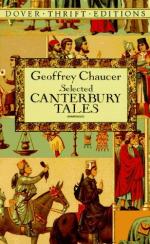|
This section contains 2,091 words (approx. 7 pages at 300 words per page) |

|
SOURCE: "The Framework of the Canterbury Tales," in University of Toronto Quarterly, Vol. XX, No. 2, January, 1951, pp. 137-54.
In the following excerpt, Clawson explains the functions of the framing narrative within the "General Prologue" and throughout the Canterbury Tales as a linking device.
[The] idea of a pilgrimage as the occasion for the telling of a sequence of stories was one of the happiest devices of Chaucer's Canterbury Tales. [Quotations are from the Complete Works edited by F. N. Robinson (1933).] The religious motive of a pilgrimage made possible the coming together on a friendly footing of representatives of many social classes; and the relative safety and cheapness of such a form of travel, especially to so famous and long-established a shrine as Canterbury, promoted a holiday spirit which encouraged music and story-telling and led to the free exchange of opinions and confidences. Thus through his adoption of the...
|
This section contains 2,091 words (approx. 7 pages at 300 words per page) |

|


